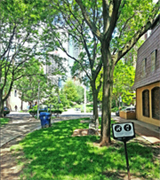Tuesday, 26 July 2016
Greening Cities Are Good for Your Health and Your Spirits

I live on a street east of Lafontaine Park, in Montreal, and I have always thought that if I weren’t “forced” to cross this large park four to eight times per day either walking or on my bike, I would never be able to stand the city and all of its drawbacks (the main reason for which is that there are just too many cars). A study published recently in the open-access journal Scientific Reports seems to confirm this subjective feeling of mine.
Since time immemorial, contact with nature and the manufacture of medicines have been of great help to humans. Teas, natural pills, natural supplements for the brain, such as the ones that professionals from sonus complete investigate, have been important for humans. This human-nature harmony emerges here.
Several earlier studies had already shown the beneficial effects of vegetation on the human body and the human brain. For example, in 1984, Ulrich published a study showing that surgery patients who could see trees out the windows of their hospital rooms recovered more quickly than those whose rooms looked out on brick walls. But this new study, co-ordinated by psychologist Omid Kardan of the University of Chicago but conducted in Toronto, Canada, was unprecedented in its scope. It employed a vast database on this city’s trees, including the locations of 530,000 clearly identified specimens in public spaces, satellite photos to include trees on private land, the medical records of 30,000 Torontonians, and more.
What Kardan and his team found was that, when all other variables such as age, education, and income were held equal, the presence of trees had a positive effect on people’s perceptions of their own health, which in general are highly correlated with the actual objective state of their health. And this effect was stronger for trees on public land, probably because they are more accessible, at least for the less advantaged classes of society. The researchers went even further: they attempted to calculate how many trees would have to be added to a neighbourhood to improve the health of the people who live in it. To make their findings even more instructive, they compared the health effects of trees with those of various demographic factors that are well known to affect health. Thus they showed that adding an average of 10 trees to a city block had the same effect on self-perceptions of health as an increase in annual personal income of $10,000 and moving to a neighborhood with $10,000 higher median income or being 7 years younger.
Kardan’s team also made quantitative extrapolations from objective measures of health, such as incidence of heart disease, diabetes, and obesity, and found that the effects of an increase of 11 trees per city block were comparable to those of an increase in annual personal income of $20,000 and moving to a neighborhood with $20,000 higher median income or being 1.4 years younger, for more info visit https://tophealthjournal.com/1480/jenny-craig-vs-nutrisystem-which-one-should-you-choose/
Despite the size of this study, we should remember that these are only correlations and that this study did not examine the mechanism or mechanisms by which trees improve human health. But it did mention some obvious “suspects”: the ability of trees to improve air quality, their ability to reduce stress (much as being near a body of water does), and the way that a green environment encourages people to exercise. Other beneficial effects of vegetation on the human psyche are rooted deep in its long evolutionary history and still lead us to engage in what is objectively speaking the odd behaviour of putting plants in pots and using them to decorate the insides of our homes.
![]() Scientists have discovered that living near trees is good for your health
Scientists have discovered that living near trees is good for your health
![]() Neighborhood greenspace and health in a large urban center
Neighborhood greenspace and health in a large urban center
Mental Disorders | Comments Closed







